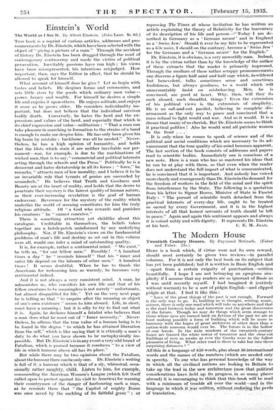The Modern House
HERE is a book which, if Virtue were not its own reward, should most certainly be given two reviews—in parallel columns. For it is not only the best book on its subject that has yet been published; but it is Written in Basic English and —apart from a certain exiguity of punctuation—written beautifully. I hope I am not betraying an egregious sim- plicity if I assume that my readers are as ignorant of-Basic as I was until recently myself. I had imagined it (entirely without warrant) to be a sort of pidgin English—and cliPped pidgin at that. I find it like this : Love of the great things of the past is not enough. Forward is the only way to go. In building as in thought, writing, music, science, there is only one road which will take us anywhere and that is the road between today and tomorrow and the great discoveries of the future. Though we may do things which seem strange to those whose eyes are turned back on fictions of the past we ate at least making possible a form of building which will be more in harmony with the hopes of great architects of other days than a nation-wide museum would ever be. -The future is in' 'the hollow of ...our hands. In the wide windows of the twentieth-century house are framed the white towns of tomorrow and the clear-cut buildings of men as awake 'as ever the Greeks' were to the fullest pleasures of living. What other rood is there to take but into these
surprising distances ? " .
All this in a language of 850 words, plus about 50 international words and the names of the numbers (which are needed only in speech). To nne who hag personal knowledge of the way
in which all the civilized nations are looking to Britain to
take up the lead ia the new architecture (now:that.political
considerations have .held. pp its progress., ii so many places abroad) it is encouraging to think that this book will be read with a minimum' of trouble all over the world—and in the language in which it Was written, without_enditiltithe perils of translation. Modem architecture has now passed out of its aggressive adolescent 'stage (at which statement those who care about the style of their reading—with memories of earlier strident and hysterical publications—will breathe deeply and thank- fully.) Mr. McGrath is sufficiently sure of himself and his subject never to find it necessary to raise his voice. Perhaps the most attractive part of his book is a long dialogue at the end, in which an architect of the old school argues against modernism with a younger colleague. There is no shirking
of issues here—no putting up of Aunt Sallies for the pleasure of knocking them down. The older man is given the use of every weapon in the armoury. His discourse might be taken as a model by several of the choleric grey-heads who have lately taken to invective where reason failed them. There has been no better primer written for those who-would under- stand the new architecture than this dialogue. The first section of the book is a skilful survey of the progress of architecture from 1800 to the present day. It is full of good things : "While the Regency was still in full flower the old order was being quietly put to death. It was the morning of a time which was to be full of the noise of railways, ships, iron and gasworks—a time of expansion, power and money— full of the surprises and shocks of living among new things— newer than anything there has been in our day." "But art is no respecter of persons, and in art to be a good man is not enough. Great and good as they were as men, their idea of art was that of a part to be played in the last act of the history of Man's development from 4004 B.C. to the Great Exhibition of 1851." "In the middle and late eighteen hundreds the shades of the prison-house became thicker and thicker as the requests in church for all things bright and beautiful became louder and louder." There follows a section on Town and Country which may be commended to those who still believe that the way to design the town of the future is on the lines of a glorified village—transport problem or no—and one on Form and Purpose for those who think that the functionalist cares nothing for beauty : "It is not enough to be right ; one has to be right in the best possible way. The first of these i3 science, the second art." Then comes Planning and Building, with subsections on Plan and Position, Materials and Structure, Apparatus, Furniture, Colour and Ornament, and Values.
The main body of the book is given up to Examples. There are critical and biographical notes on 128 architects of almost every nationality (it might be said that the selection is too catholic) with 275 illustrations of their work and 113 special plans. It is typical of the thoroughness and rationality of this book that the floor area and cost of each house illustrated are given, and that the special plans are drawn on a ten-foot-squared grille, and the purpose of each room indicated by a conventional picture-symbol, so that comparison is made easy. Finally, come an amusing section "In the Languages of Babel," in which varidus quotations rendered into Basic in other parts of the book are given in their original form, a note on Basic by Mr. C. K. Ogden, its inventor, and, on a folded page rather smaller than foolscap, its vocabulary. This is more than a book—it is a portent.
G. M. BOUMPIIREY.











































 Previous page
Previous page